Employee Engagement and Retention in the Labour Market: A Report
VerifiedAdded on 2023/02/07
|24
|8543
|93
Report
AI Summary
This report examines the crucial relationship between employee engagement and retention within the evolving labour market, particularly in the post-COVID-19 era. It explores the significant impact of these factors on global talent management within multinational corporations, using Atos as a case study. The report evaluates human resources strategies, focusing on recruiting and retaining talented employees. Key topics include the concept of global talent management, human resources strategies in a competitive market, organizational linkages, attraction and selection techniques, training and development programs, compensation strategies, and retention practices. It also covers reduction and removal strategies. The analysis highlights how organizations can leverage effective HR practices to gain a competitive advantage through talent management in the face of dynamic labour market conditions.

NAME:
STUDENT NO:
STUDENT NO:
Paraphrase This Document
Need a fresh take? Get an instant paraphrase of this document with our AI Paraphraser
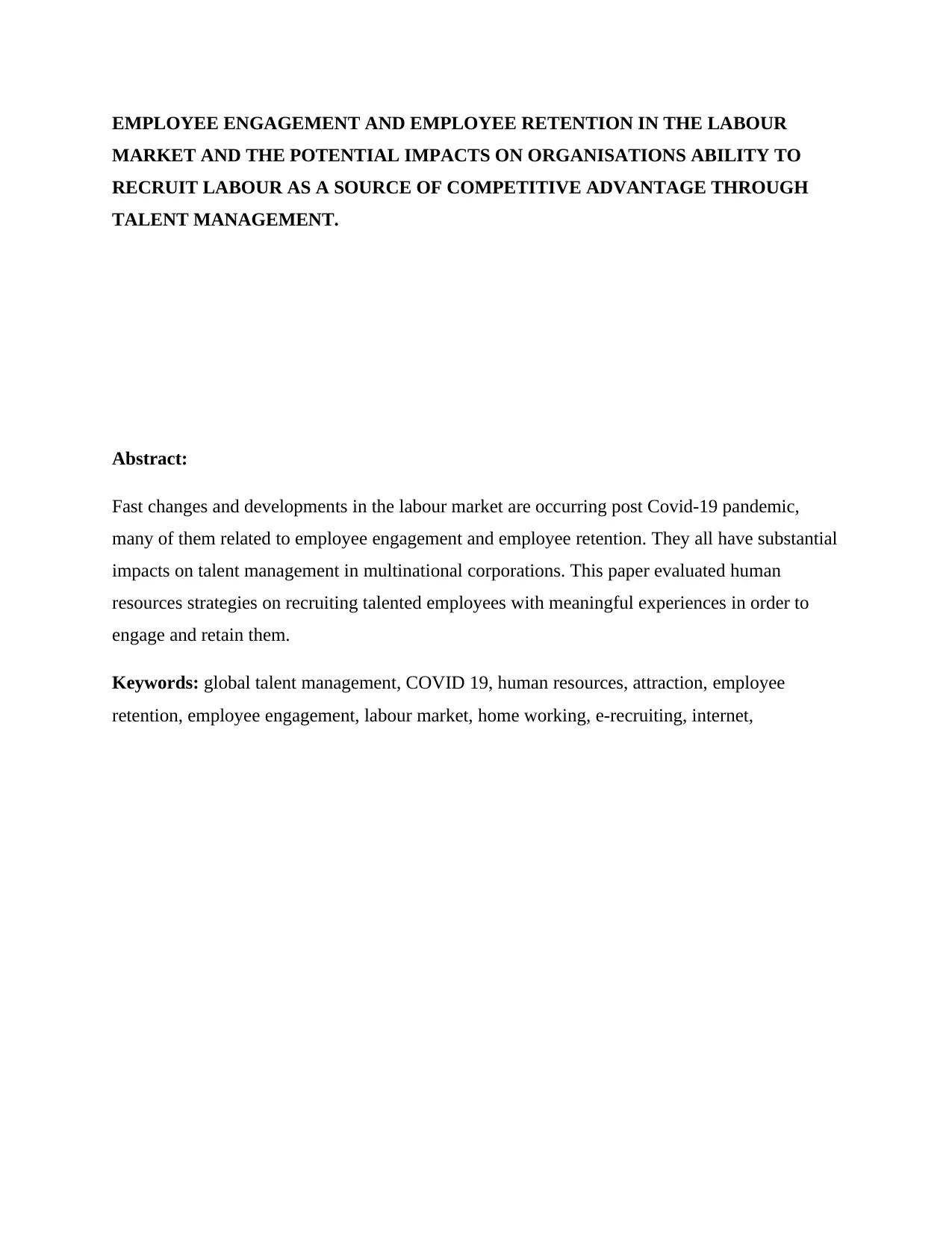
EMPLOYEE ENGAGEMENT AND EMPLOYEE RETENTION IN THE LABOUR
MARKET AND THE POTENTIAL IMPACTS ON ORGANISATIONS ABILITY TO
RECRUIT LABOUR AS A SOURCE OF COMPETITIVE ADVANTAGE THROUGH
TALENT MANAGEMENT.
Abstract:
Fast changes and developments in the labour market are occurring post Covid-19 pandemic,
many of them related to employee engagement and employee retention. They all have substantial
impacts on talent management in multinational corporations. This paper evaluated human
resources strategies on recruiting talented employees with meaningful experiences in order to
engage and retain them.
Keywords: global talent management, COVID 19, human resources, attraction, employee
retention, employee engagement, labour market, home working, e-recruiting, internet,
MARKET AND THE POTENTIAL IMPACTS ON ORGANISATIONS ABILITY TO
RECRUIT LABOUR AS A SOURCE OF COMPETITIVE ADVANTAGE THROUGH
TALENT MANAGEMENT.
Abstract:
Fast changes and developments in the labour market are occurring post Covid-19 pandemic,
many of them related to employee engagement and employee retention. They all have substantial
impacts on talent management in multinational corporations. This paper evaluated human
resources strategies on recruiting talented employees with meaningful experiences in order to
engage and retain them.
Keywords: global talent management, COVID 19, human resources, attraction, employee
retention, employee engagement, labour market, home working, e-recruiting, internet,
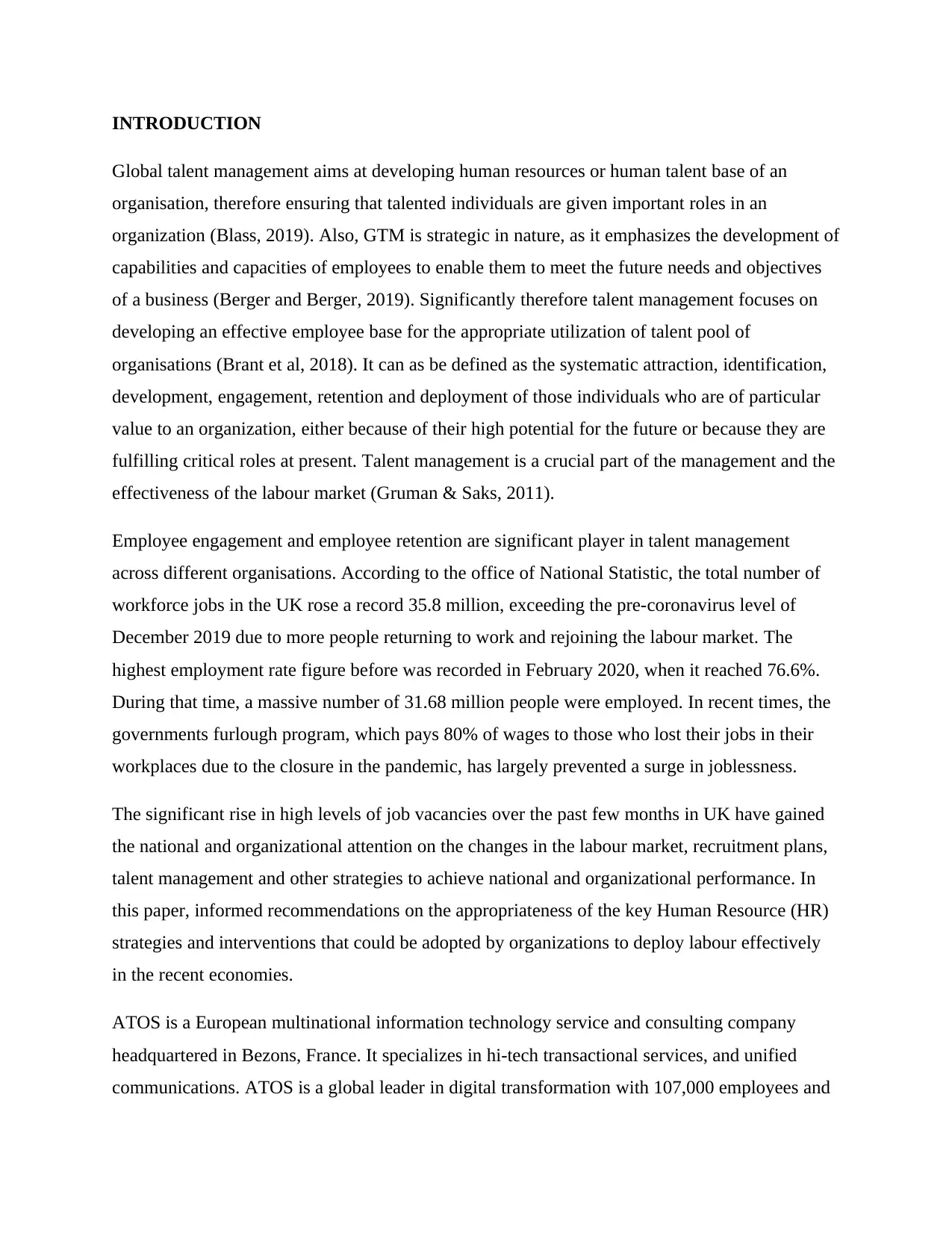
INTRODUCTION
Global talent management aims at developing human resources or human talent base of an
organisation, therefore ensuring that talented individuals are given important roles in an
organization (Blass, 2019). Also, GTM is strategic in nature, as it emphasizes the development of
capabilities and capacities of employees to enable them to meet the future needs and objectives
of a business (Berger and Berger, 2019). Significantly therefore talent management focuses on
developing an effective employee base for the appropriate utilization of talent pool of
organisations (Brant et al, 2018). It can as be defined as the systematic attraction, identification,
development, engagement, retention and deployment of those individuals who are of particular
value to an organization, either because of their high potential for the future or because they are
fulfilling critical roles at present. Talent management is a crucial part of the management and the
effectiveness of the labour market (Gruman & Saks, 2011).
Employee engagement and employee retention are significant player in talent management
across different organisations. According to the office of National Statistic, the total number of
workforce jobs in the UK rose a record 35.8 million, exceeding the pre-coronavirus level of
December 2019 due to more people returning to work and rejoining the labour market. The
highest employment rate figure before was recorded in February 2020, when it reached 76.6%.
During that time, a massive number of 31.68 million people were employed. In recent times, the
governments furlough program, which pays 80% of wages to those who lost their jobs in their
workplaces due to the closure in the pandemic, has largely prevented a surge in joblessness.
The significant rise in high levels of job vacancies over the past few months in UK have gained
the national and organizational attention on the changes in the labour market, recruitment plans,
talent management and other strategies to achieve national and organizational performance. In
this paper, informed recommendations on the appropriateness of the key Human Resource (HR)
strategies and interventions that could be adopted by organizations to deploy labour effectively
in the recent economies.
ATOS is a European multinational information technology service and consulting company
headquartered in Bezons, France. It specializes in hi-tech transactional services, and unified
communications. ATOS is a global leader in digital transformation with 107,000 employees and
Global talent management aims at developing human resources or human talent base of an
organisation, therefore ensuring that talented individuals are given important roles in an
organization (Blass, 2019). Also, GTM is strategic in nature, as it emphasizes the development of
capabilities and capacities of employees to enable them to meet the future needs and objectives
of a business (Berger and Berger, 2019). Significantly therefore talent management focuses on
developing an effective employee base for the appropriate utilization of talent pool of
organisations (Brant et al, 2018). It can as be defined as the systematic attraction, identification,
development, engagement, retention and deployment of those individuals who are of particular
value to an organization, either because of their high potential for the future or because they are
fulfilling critical roles at present. Talent management is a crucial part of the management and the
effectiveness of the labour market (Gruman & Saks, 2011).
Employee engagement and employee retention are significant player in talent management
across different organisations. According to the office of National Statistic, the total number of
workforce jobs in the UK rose a record 35.8 million, exceeding the pre-coronavirus level of
December 2019 due to more people returning to work and rejoining the labour market. The
highest employment rate figure before was recorded in February 2020, when it reached 76.6%.
During that time, a massive number of 31.68 million people were employed. In recent times, the
governments furlough program, which pays 80% of wages to those who lost their jobs in their
workplaces due to the closure in the pandemic, has largely prevented a surge in joblessness.
The significant rise in high levels of job vacancies over the past few months in UK have gained
the national and organizational attention on the changes in the labour market, recruitment plans,
talent management and other strategies to achieve national and organizational performance. In
this paper, informed recommendations on the appropriateness of the key Human Resource (HR)
strategies and interventions that could be adopted by organizations to deploy labour effectively
in the recent economies.
ATOS is a European multinational information technology service and consulting company
headquartered in Bezons, France. It specializes in hi-tech transactional services, and unified
communications. ATOS is a global leader in digital transformation with 107,000 employees and
⊘ This is a preview!⊘
Do you want full access?
Subscribe today to unlock all pages.

Trusted by 1+ million students worldwide
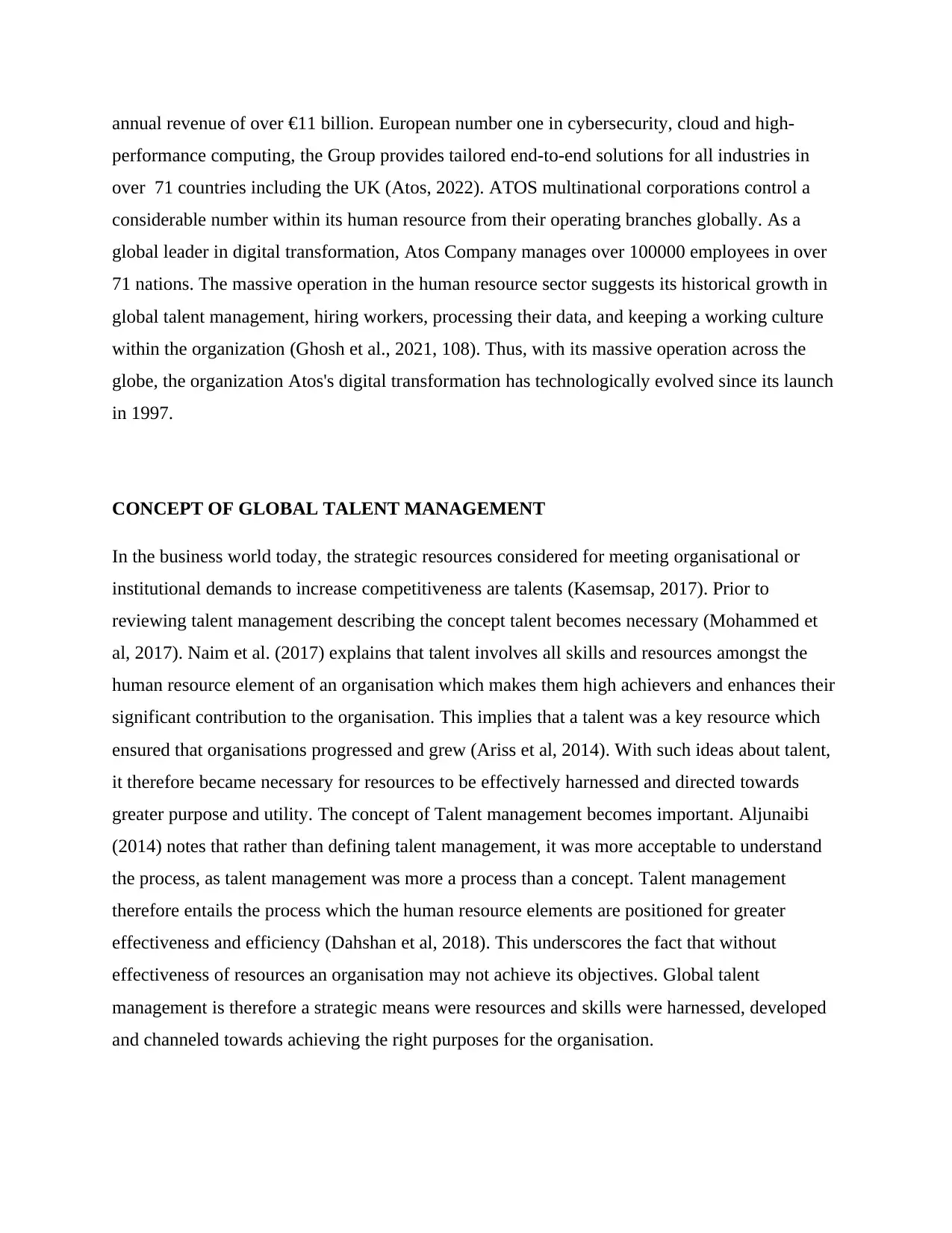
annual revenue of over €11 billion. European number one in cybersecurity, cloud and high-
performance computing, the Group provides tailored end-to-end solutions for all industries in
over 71 countries including the UK (Atos, 2022). ATOS multinational corporations control a
considerable number within its human resource from their operating branches globally. As a
global leader in digital transformation, Atos Company manages over 100000 employees in over
71 nations. The massive operation in the human resource sector suggests its historical growth in
global talent management, hiring workers, processing their data, and keeping a working culture
within the organization (Ghosh et al., 2021, 108). Thus, with its massive operation across the
globe, the organization Atos's digital transformation has technologically evolved since its launch
in 1997.
CONCEPT OF GLOBAL TALENT MANAGEMENT
In the business world today, the strategic resources considered for meeting organisational or
institutional demands to increase competitiveness are talents (Kasemsap, 2017). Prior to
reviewing talent management describing the concept talent becomes necessary (Mohammed et
al, 2017). Naim et al. (2017) explains that talent involves all skills and resources amongst the
human resource element of an organisation which makes them high achievers and enhances their
significant contribution to the organisation. This implies that a talent was a key resource which
ensured that organisations progressed and grew (Ariss et al, 2014). With such ideas about talent,
it therefore became necessary for resources to be effectively harnessed and directed towards
greater purpose and utility. The concept of Talent management becomes important. Aljunaibi
(2014) notes that rather than defining talent management, it was more acceptable to understand
the process, as talent management was more a process than a concept. Talent management
therefore entails the process which the human resource elements are positioned for greater
effectiveness and efficiency (Dahshan et al, 2018). This underscores the fact that without
effectiveness of resources an organisation may not achieve its objectives. Global talent
management is therefore a strategic means were resources and skills were harnessed, developed
and channeled towards achieving the right purposes for the organisation.
performance computing, the Group provides tailored end-to-end solutions for all industries in
over 71 countries including the UK (Atos, 2022). ATOS multinational corporations control a
considerable number within its human resource from their operating branches globally. As a
global leader in digital transformation, Atos Company manages over 100000 employees in over
71 nations. The massive operation in the human resource sector suggests its historical growth in
global talent management, hiring workers, processing their data, and keeping a working culture
within the organization (Ghosh et al., 2021, 108). Thus, with its massive operation across the
globe, the organization Atos's digital transformation has technologically evolved since its launch
in 1997.
CONCEPT OF GLOBAL TALENT MANAGEMENT
In the business world today, the strategic resources considered for meeting organisational or
institutional demands to increase competitiveness are talents (Kasemsap, 2017). Prior to
reviewing talent management describing the concept talent becomes necessary (Mohammed et
al, 2017). Naim et al. (2017) explains that talent involves all skills and resources amongst the
human resource element of an organisation which makes them high achievers and enhances their
significant contribution to the organisation. This implies that a talent was a key resource which
ensured that organisations progressed and grew (Ariss et al, 2014). With such ideas about talent,
it therefore became necessary for resources to be effectively harnessed and directed towards
greater purpose and utility. The concept of Talent management becomes important. Aljunaibi
(2014) notes that rather than defining talent management, it was more acceptable to understand
the process, as talent management was more a process than a concept. Talent management
therefore entails the process which the human resource elements are positioned for greater
effectiveness and efficiency (Dahshan et al, 2018). This underscores the fact that without
effectiveness of resources an organisation may not achieve its objectives. Global talent
management is therefore a strategic means were resources and skills were harnessed, developed
and channeled towards achieving the right purposes for the organisation.
Paraphrase This Document
Need a fresh take? Get an instant paraphrase of this document with our AI Paraphraser
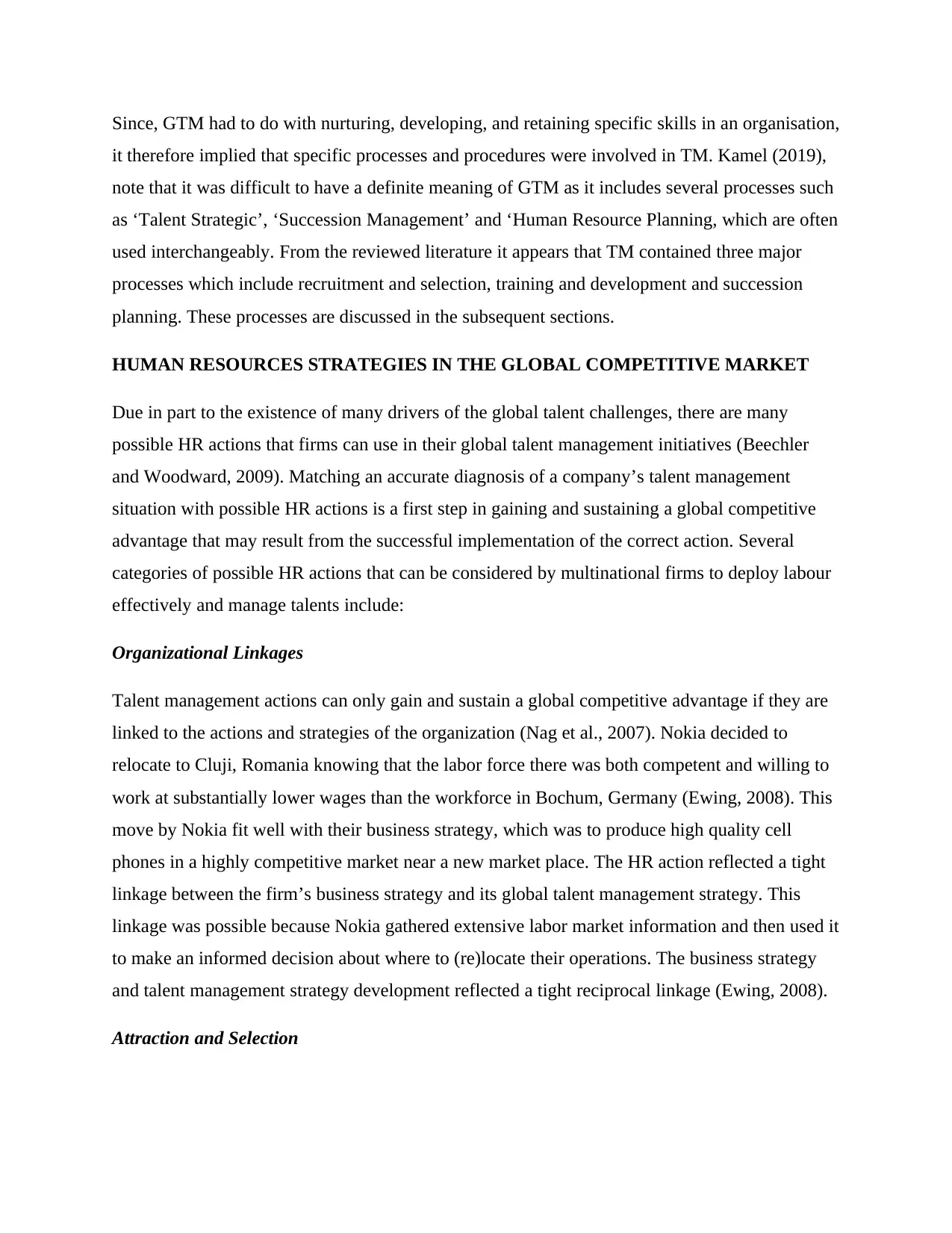
Since, GTM had to do with nurturing, developing, and retaining specific skills in an organisation,
it therefore implied that specific processes and procedures were involved in TM. Kamel (2019),
note that it was difficult to have a definite meaning of GTM as it includes several processes such
as ‘Talent Strategic’, ‘Succession Management’ and ‘Human Resource Planning, which are often
used interchangeably. From the reviewed literature it appears that TM contained three major
processes which include recruitment and selection, training and development and succession
planning. These processes are discussed in the subsequent sections.
HUMAN RESOURCES STRATEGIES IN THE GLOBAL COMPETITIVE MARKET
Due in part to the existence of many drivers of the global talent challenges, there are many
possible HR actions that firms can use in their global talent management initiatives (Beechler
and Woodward, 2009). Matching an accurate diagnosis of a company’s talent management
situation with possible HR actions is a first step in gaining and sustaining a global competitive
advantage that may result from the successful implementation of the correct action. Several
categories of possible HR actions that can be considered by multinational firms to deploy labour
effectively and manage talents include:
Organizational Linkages
Talent management actions can only gain and sustain a global competitive advantage if they are
linked to the actions and strategies of the organization (Nag et al., 2007). Nokia decided to
relocate to Cluji, Romania knowing that the labor force there was both competent and willing to
work at substantially lower wages than the workforce in Bochum, Germany (Ewing, 2008). This
move by Nokia fit well with their business strategy, which was to produce high quality cell
phones in a highly competitive market near a new market place. The HR action reflected a tight
linkage between the firm’s business strategy and its global talent management strategy. This
linkage was possible because Nokia gathered extensive labor market information and then used it
to make an informed decision about where to (re)locate their operations. The business strategy
and talent management strategy development reflected a tight reciprocal linkage (Ewing, 2008).
Attraction and Selection
it therefore implied that specific processes and procedures were involved in TM. Kamel (2019),
note that it was difficult to have a definite meaning of GTM as it includes several processes such
as ‘Talent Strategic’, ‘Succession Management’ and ‘Human Resource Planning, which are often
used interchangeably. From the reviewed literature it appears that TM contained three major
processes which include recruitment and selection, training and development and succession
planning. These processes are discussed in the subsequent sections.
HUMAN RESOURCES STRATEGIES IN THE GLOBAL COMPETITIVE MARKET
Due in part to the existence of many drivers of the global talent challenges, there are many
possible HR actions that firms can use in their global talent management initiatives (Beechler
and Woodward, 2009). Matching an accurate diagnosis of a company’s talent management
situation with possible HR actions is a first step in gaining and sustaining a global competitive
advantage that may result from the successful implementation of the correct action. Several
categories of possible HR actions that can be considered by multinational firms to deploy labour
effectively and manage talents include:
Organizational Linkages
Talent management actions can only gain and sustain a global competitive advantage if they are
linked to the actions and strategies of the organization (Nag et al., 2007). Nokia decided to
relocate to Cluji, Romania knowing that the labor force there was both competent and willing to
work at substantially lower wages than the workforce in Bochum, Germany (Ewing, 2008). This
move by Nokia fit well with their business strategy, which was to produce high quality cell
phones in a highly competitive market near a new market place. The HR action reflected a tight
linkage between the firm’s business strategy and its global talent management strategy. This
linkage was possible because Nokia gathered extensive labor market information and then used it
to make an informed decision about where to (re)locate their operations. The business strategy
and talent management strategy development reflected a tight reciprocal linkage (Ewing, 2008).
Attraction and Selection
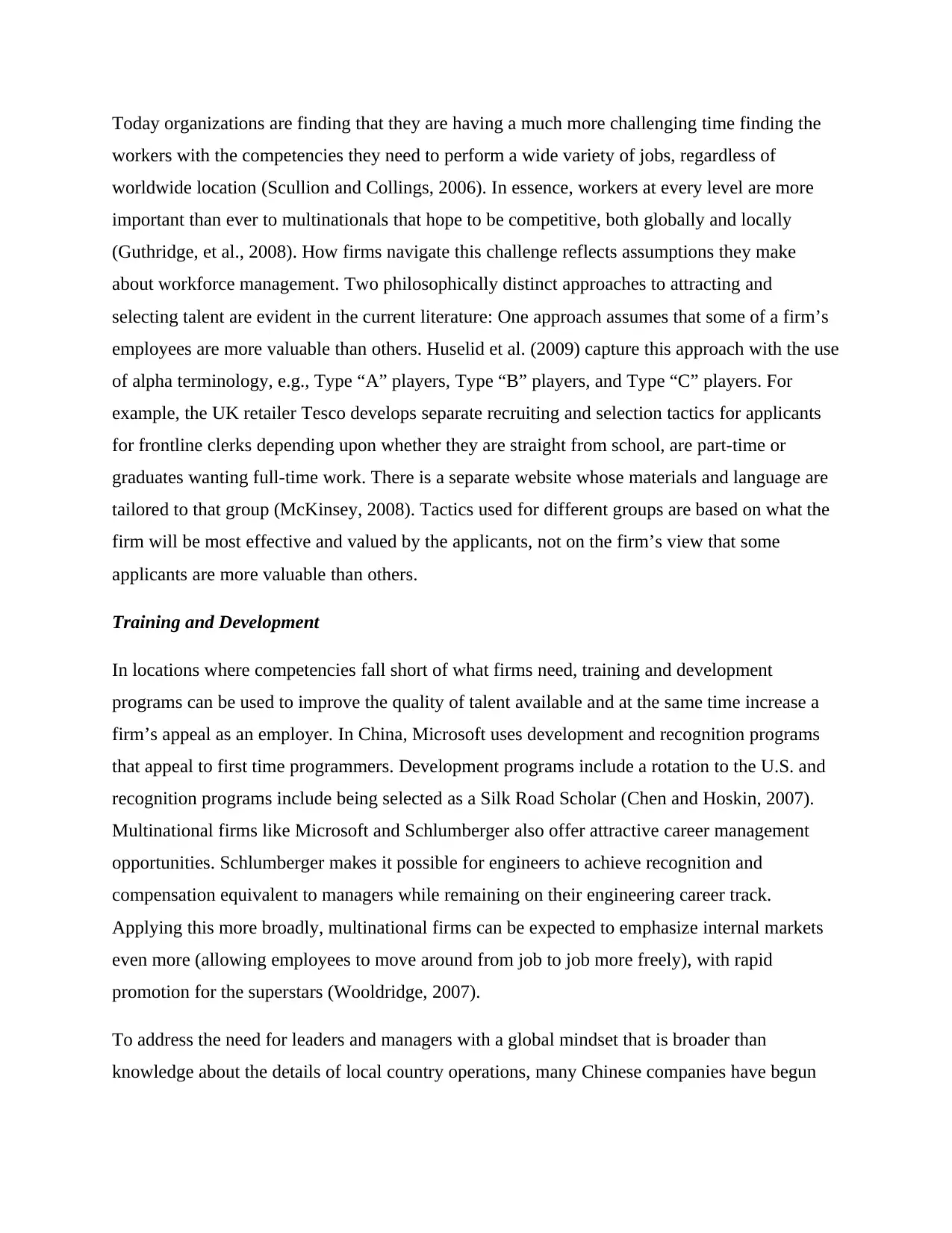
Today organizations are finding that they are having a much more challenging time finding the
workers with the competencies they need to perform a wide variety of jobs, regardless of
worldwide location (Scullion and Collings, 2006). In essence, workers at every level are more
important than ever to multinationals that hope to be competitive, both globally and locally
(Guthridge, et al., 2008). How firms navigate this challenge reflects assumptions they make
about workforce management. Two philosophically distinct approaches to attracting and
selecting talent are evident in the current literature: One approach assumes that some of a firm’s
employees are more valuable than others. Huselid et al. (2009) capture this approach with the use
of alpha terminology, e.g., Type “A” players, Type “B” players, and Type “C” players. For
example, the UK retailer Tesco develops separate recruiting and selection tactics for applicants
for frontline clerks depending upon whether they are straight from school, are part-time or
graduates wanting full-time work. There is a separate website whose materials and language are
tailored to that group (McKinsey, 2008). Tactics used for different groups are based on what the
firm will be most effective and valued by the applicants, not on the firm’s view that some
applicants are more valuable than others.
Training and Development
In locations where competencies fall short of what firms need, training and development
programs can be used to improve the quality of talent available and at the same time increase a
firm’s appeal as an employer. In China, Microsoft uses development and recognition programs
that appeal to first time programmers. Development programs include a rotation to the U.S. and
recognition programs include being selected as a Silk Road Scholar (Chen and Hoskin, 2007).
Multinational firms like Microsoft and Schlumberger also offer attractive career management
opportunities. Schlumberger makes it possible for engineers to achieve recognition and
compensation equivalent to managers while remaining on their engineering career track.
Applying this more broadly, multinational firms can be expected to emphasize internal markets
even more (allowing employees to move around from job to job more freely), with rapid
promotion for the superstars (Wooldridge, 2007).
To address the need for leaders and managers with a global mindset that is broader than
knowledge about the details of local country operations, many Chinese companies have begun
workers with the competencies they need to perform a wide variety of jobs, regardless of
worldwide location (Scullion and Collings, 2006). In essence, workers at every level are more
important than ever to multinationals that hope to be competitive, both globally and locally
(Guthridge, et al., 2008). How firms navigate this challenge reflects assumptions they make
about workforce management. Two philosophically distinct approaches to attracting and
selecting talent are evident in the current literature: One approach assumes that some of a firm’s
employees are more valuable than others. Huselid et al. (2009) capture this approach with the use
of alpha terminology, e.g., Type “A” players, Type “B” players, and Type “C” players. For
example, the UK retailer Tesco develops separate recruiting and selection tactics for applicants
for frontline clerks depending upon whether they are straight from school, are part-time or
graduates wanting full-time work. There is a separate website whose materials and language are
tailored to that group (McKinsey, 2008). Tactics used for different groups are based on what the
firm will be most effective and valued by the applicants, not on the firm’s view that some
applicants are more valuable than others.
Training and Development
In locations where competencies fall short of what firms need, training and development
programs can be used to improve the quality of talent available and at the same time increase a
firm’s appeal as an employer. In China, Microsoft uses development and recognition programs
that appeal to first time programmers. Development programs include a rotation to the U.S. and
recognition programs include being selected as a Silk Road Scholar (Chen and Hoskin, 2007).
Multinational firms like Microsoft and Schlumberger also offer attractive career management
opportunities. Schlumberger makes it possible for engineers to achieve recognition and
compensation equivalent to managers while remaining on their engineering career track.
Applying this more broadly, multinational firms can be expected to emphasize internal markets
even more (allowing employees to move around from job to job more freely), with rapid
promotion for the superstars (Wooldridge, 2007).
To address the need for leaders and managers with a global mindset that is broader than
knowledge about the details of local country operations, many Chinese companies have begun
⊘ This is a preview!⊘
Do you want full access?
Subscribe today to unlock all pages.

Trusted by 1+ million students worldwide
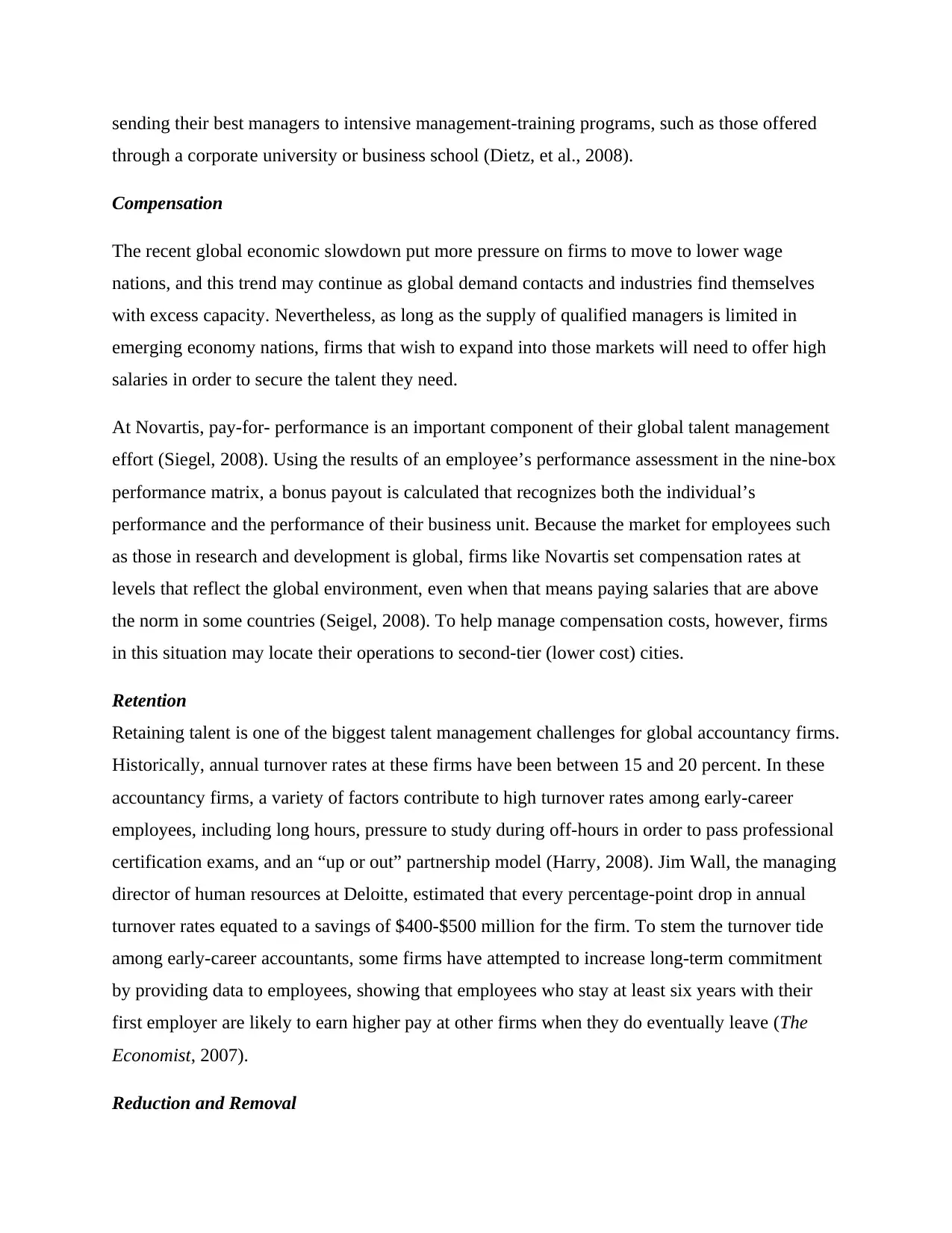
sending their best managers to intensive management-training programs, such as those offered
through a corporate university or business school (Dietz, et al., 2008).
Compensation
The recent global economic slowdown put more pressure on firms to move to lower wage
nations, and this trend may continue as global demand contacts and industries find themselves
with excess capacity. Nevertheless, as long as the supply of qualified managers is limited in
emerging economy nations, firms that wish to expand into those markets will need to offer high
salaries in order to secure the talent they need.
At Novartis, pay-for- performance is an important component of their global talent management
effort (Siegel, 2008). Using the results of an employee’s performance assessment in the nine-box
performance matrix, a bonus payout is calculated that recognizes both the individual’s
performance and the performance of their business unit. Because the market for employees such
as those in research and development is global, firms like Novartis set compensation rates at
levels that reflect the global environment, even when that means paying salaries that are above
the norm in some countries (Seigel, 2008). To help manage compensation costs, however, firms
in this situation may locate their operations to second-tier (lower cost) cities.
Retention
Retaining talent is one of the biggest talent management challenges for global accountancy firms.
Historically, annual turnover rates at these firms have been between 15 and 20 percent. In these
accountancy firms, a variety of factors contribute to high turnover rates among early-career
employees, including long hours, pressure to study during off-hours in order to pass professional
certification exams, and an “up or out” partnership model (Harry, 2008). Jim Wall, the managing
director of human resources at Deloitte, estimated that every percentage-point drop in annual
turnover rates equated to a savings of $400-$500 million for the firm. To stem the turnover tide
among early-career accountants, some firms have attempted to increase long-term commitment
by providing data to employees, showing that employees who stay at least six years with their
first employer are likely to earn higher pay at other firms when they do eventually leave (The
Economist, 2007).
Reduction and Removal
through a corporate university or business school (Dietz, et al., 2008).
Compensation
The recent global economic slowdown put more pressure on firms to move to lower wage
nations, and this trend may continue as global demand contacts and industries find themselves
with excess capacity. Nevertheless, as long as the supply of qualified managers is limited in
emerging economy nations, firms that wish to expand into those markets will need to offer high
salaries in order to secure the talent they need.
At Novartis, pay-for- performance is an important component of their global talent management
effort (Siegel, 2008). Using the results of an employee’s performance assessment in the nine-box
performance matrix, a bonus payout is calculated that recognizes both the individual’s
performance and the performance of their business unit. Because the market for employees such
as those in research and development is global, firms like Novartis set compensation rates at
levels that reflect the global environment, even when that means paying salaries that are above
the norm in some countries (Seigel, 2008). To help manage compensation costs, however, firms
in this situation may locate their operations to second-tier (lower cost) cities.
Retention
Retaining talent is one of the biggest talent management challenges for global accountancy firms.
Historically, annual turnover rates at these firms have been between 15 and 20 percent. In these
accountancy firms, a variety of factors contribute to high turnover rates among early-career
employees, including long hours, pressure to study during off-hours in order to pass professional
certification exams, and an “up or out” partnership model (Harry, 2008). Jim Wall, the managing
director of human resources at Deloitte, estimated that every percentage-point drop in annual
turnover rates equated to a savings of $400-$500 million for the firm. To stem the turnover tide
among early-career accountants, some firms have attempted to increase long-term commitment
by providing data to employees, showing that employees who stay at least six years with their
first employer are likely to earn higher pay at other firms when they do eventually leave (The
Economist, 2007).
Reduction and Removal
Paraphrase This Document
Need a fresh take? Get an instant paraphrase of this document with our AI Paraphraser
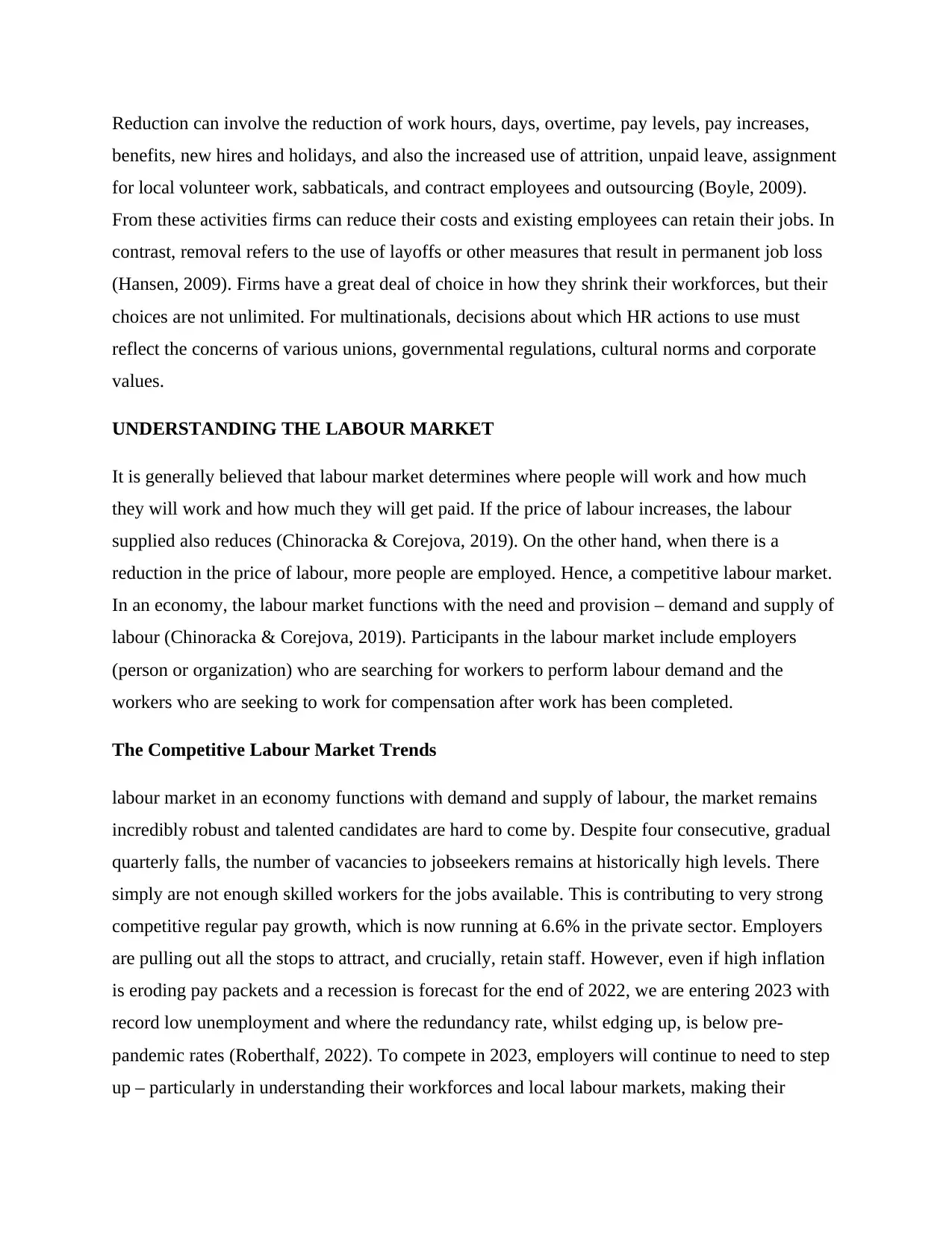
Reduction can involve the reduction of work hours, days, overtime, pay levels, pay increases,
benefits, new hires and holidays, and also the increased use of attrition, unpaid leave, assignment
for local volunteer work, sabbaticals, and contract employees and outsourcing (Boyle, 2009).
From these activities firms can reduce their costs and existing employees can retain their jobs. In
contrast, removal refers to the use of layoffs or other measures that result in permanent job loss
(Hansen, 2009). Firms have a great deal of choice in how they shrink their workforces, but their
choices are not unlimited. For multinationals, decisions about which HR actions to use must
reflect the concerns of various unions, governmental regulations, cultural norms and corporate
values.
UNDERSTANDING THE LABOUR MARKET
It is generally believed that labour market determines where people will work and how much
they will work and how much they will get paid. If the price of labour increases, the labour
supplied also reduces (Chinoracka & Corejova, 2019). On the other hand, when there is a
reduction in the price of labour, more people are employed. Hence, a competitive labour market.
In an economy, the labour market functions with the need and provision – demand and supply of
labour (Chinoracka & Corejova, 2019). Participants in the labour market include employers
(person or organization) who are searching for workers to perform labour demand and the
workers who are seeking to work for compensation after work has been completed.
The Competitive Labour Market Trends
labour market in an economy functions with demand and supply of labour, the market remains
incredibly robust and talented candidates are hard to come by. Despite four consecutive, gradual
quarterly falls, the number of vacancies to jobseekers remains at historically high levels. There
simply are not enough skilled workers for the jobs available. This is contributing to very strong
competitive regular pay growth, which is now running at 6.6% in the private sector. Employers
are pulling out all the stops to attract, and crucially, retain staff. However, even if high inflation
is eroding pay packets and a recession is forecast for the end of 2022, we are entering 2023 with
record low unemployment and where the redundancy rate, whilst edging up, is below pre-
pandemic rates (Roberthalf, 2022). To compete in 2023, employers will continue to need to step
up – particularly in understanding their workforces and local labour markets, making their
benefits, new hires and holidays, and also the increased use of attrition, unpaid leave, assignment
for local volunteer work, sabbaticals, and contract employees and outsourcing (Boyle, 2009).
From these activities firms can reduce their costs and existing employees can retain their jobs. In
contrast, removal refers to the use of layoffs or other measures that result in permanent job loss
(Hansen, 2009). Firms have a great deal of choice in how they shrink their workforces, but their
choices are not unlimited. For multinationals, decisions about which HR actions to use must
reflect the concerns of various unions, governmental regulations, cultural norms and corporate
values.
UNDERSTANDING THE LABOUR MARKET
It is generally believed that labour market determines where people will work and how much
they will work and how much they will get paid. If the price of labour increases, the labour
supplied also reduces (Chinoracka & Corejova, 2019). On the other hand, when there is a
reduction in the price of labour, more people are employed. Hence, a competitive labour market.
In an economy, the labour market functions with the need and provision – demand and supply of
labour (Chinoracka & Corejova, 2019). Participants in the labour market include employers
(person or organization) who are searching for workers to perform labour demand and the
workers who are seeking to work for compensation after work has been completed.
The Competitive Labour Market Trends
labour market in an economy functions with demand and supply of labour, the market remains
incredibly robust and talented candidates are hard to come by. Despite four consecutive, gradual
quarterly falls, the number of vacancies to jobseekers remains at historically high levels. There
simply are not enough skilled workers for the jobs available. This is contributing to very strong
competitive regular pay growth, which is now running at 6.6% in the private sector. Employers
are pulling out all the stops to attract, and crucially, retain staff. However, even if high inflation
is eroding pay packets and a recession is forecast for the end of 2022, we are entering 2023 with
record low unemployment and where the redundancy rate, whilst edging up, is below pre-
pandemic rates (Roberthalf, 2022). To compete in 2023, employers will continue to need to step
up – particularly in understanding their workforces and local labour markets, making their
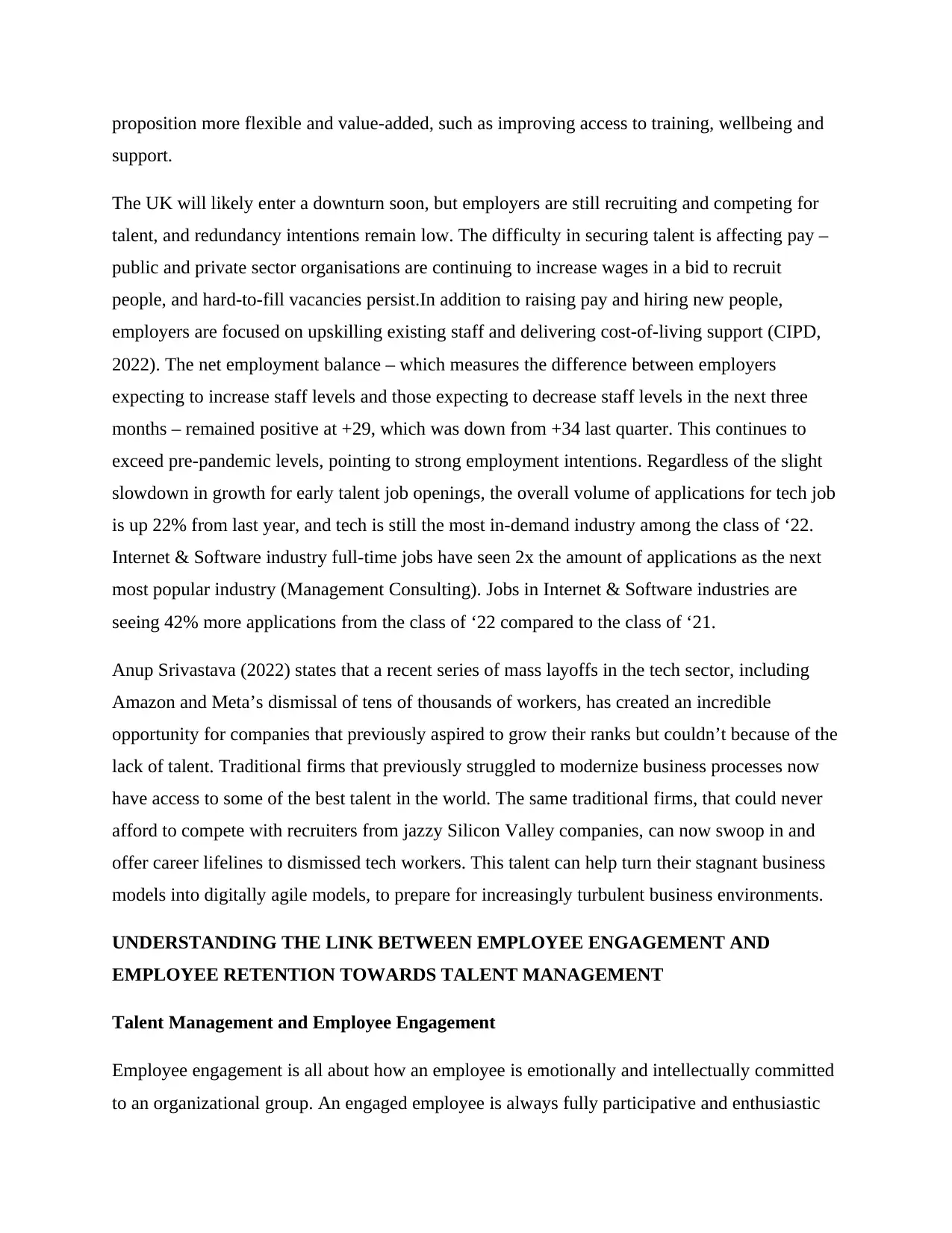
proposition more flexible and value-added, such as improving access to training, wellbeing and
support.
The UK will likely enter a downturn soon, but employers are still recruiting and competing for
talent, and redundancy intentions remain low. The difficulty in securing talent is affecting pay –
public and private sector organisations are continuing to increase wages in a bid to recruit
people, and hard-to-fill vacancies persist.In addition to raising pay and hiring new people,
employers are focused on upskilling existing staff and delivering cost-of-living support (CIPD,
2022). The net employment balance – which measures the difference between employers
expecting to increase staff levels and those expecting to decrease staff levels in the next three
months – remained positive at +29, which was down from +34 last quarter. This continues to
exceed pre-pandemic levels, pointing to strong employment intentions. Regardless of the slight
slowdown in growth for early talent job openings, the overall volume of applications for tech job
is up 22% from last year, and tech is still the most in-demand industry among the class of ‘22.
Internet & Software industry full-time jobs have seen 2x the amount of applications as the next
most popular industry (Management Consulting). Jobs in Internet & Software industries are
seeing 42% more applications from the class of ‘22 compared to the class of ‘21.
Anup Srivastava (2022) states that a recent series of mass layoffs in the tech sector, including
Amazon and Meta’s dismissal of tens of thousands of workers, has created an incredible
opportunity for companies that previously aspired to grow their ranks but couldn’t because of the
lack of talent. Traditional firms that previously struggled to modernize business processes now
have access to some of the best talent in the world. The same traditional firms, that could never
afford to compete with recruiters from jazzy Silicon Valley companies, can now swoop in and
offer career lifelines to dismissed tech workers. This talent can help turn their stagnant business
models into digitally agile models, to prepare for increasingly turbulent business environments.
UNDERSTANDING THE LINK BETWEEN EMPLOYEE ENGAGEMENT AND
EMPLOYEE RETENTION TOWARDS TALENT MANAGEMENT
Talent Management and Employee Engagement
Employee engagement is all about how an employee is emotionally and intellectually committed
to an organizational group. An engaged employee is always fully participative and enthusiastic
support.
The UK will likely enter a downturn soon, but employers are still recruiting and competing for
talent, and redundancy intentions remain low. The difficulty in securing talent is affecting pay –
public and private sector organisations are continuing to increase wages in a bid to recruit
people, and hard-to-fill vacancies persist.In addition to raising pay and hiring new people,
employers are focused on upskilling existing staff and delivering cost-of-living support (CIPD,
2022). The net employment balance – which measures the difference between employers
expecting to increase staff levels and those expecting to decrease staff levels in the next three
months – remained positive at +29, which was down from +34 last quarter. This continues to
exceed pre-pandemic levels, pointing to strong employment intentions. Regardless of the slight
slowdown in growth for early talent job openings, the overall volume of applications for tech job
is up 22% from last year, and tech is still the most in-demand industry among the class of ‘22.
Internet & Software industry full-time jobs have seen 2x the amount of applications as the next
most popular industry (Management Consulting). Jobs in Internet & Software industries are
seeing 42% more applications from the class of ‘22 compared to the class of ‘21.
Anup Srivastava (2022) states that a recent series of mass layoffs in the tech sector, including
Amazon and Meta’s dismissal of tens of thousands of workers, has created an incredible
opportunity for companies that previously aspired to grow their ranks but couldn’t because of the
lack of talent. Traditional firms that previously struggled to modernize business processes now
have access to some of the best talent in the world. The same traditional firms, that could never
afford to compete with recruiters from jazzy Silicon Valley companies, can now swoop in and
offer career lifelines to dismissed tech workers. This talent can help turn their stagnant business
models into digitally agile models, to prepare for increasingly turbulent business environments.
UNDERSTANDING THE LINK BETWEEN EMPLOYEE ENGAGEMENT AND
EMPLOYEE RETENTION TOWARDS TALENT MANAGEMENT
Talent Management and Employee Engagement
Employee engagement is all about how an employee is emotionally and intellectually committed
to an organizational group. An engaged employee is always fully participative and enthusiastic
⊘ This is a preview!⊘
Do you want full access?
Subscribe today to unlock all pages.

Trusted by 1+ million students worldwide
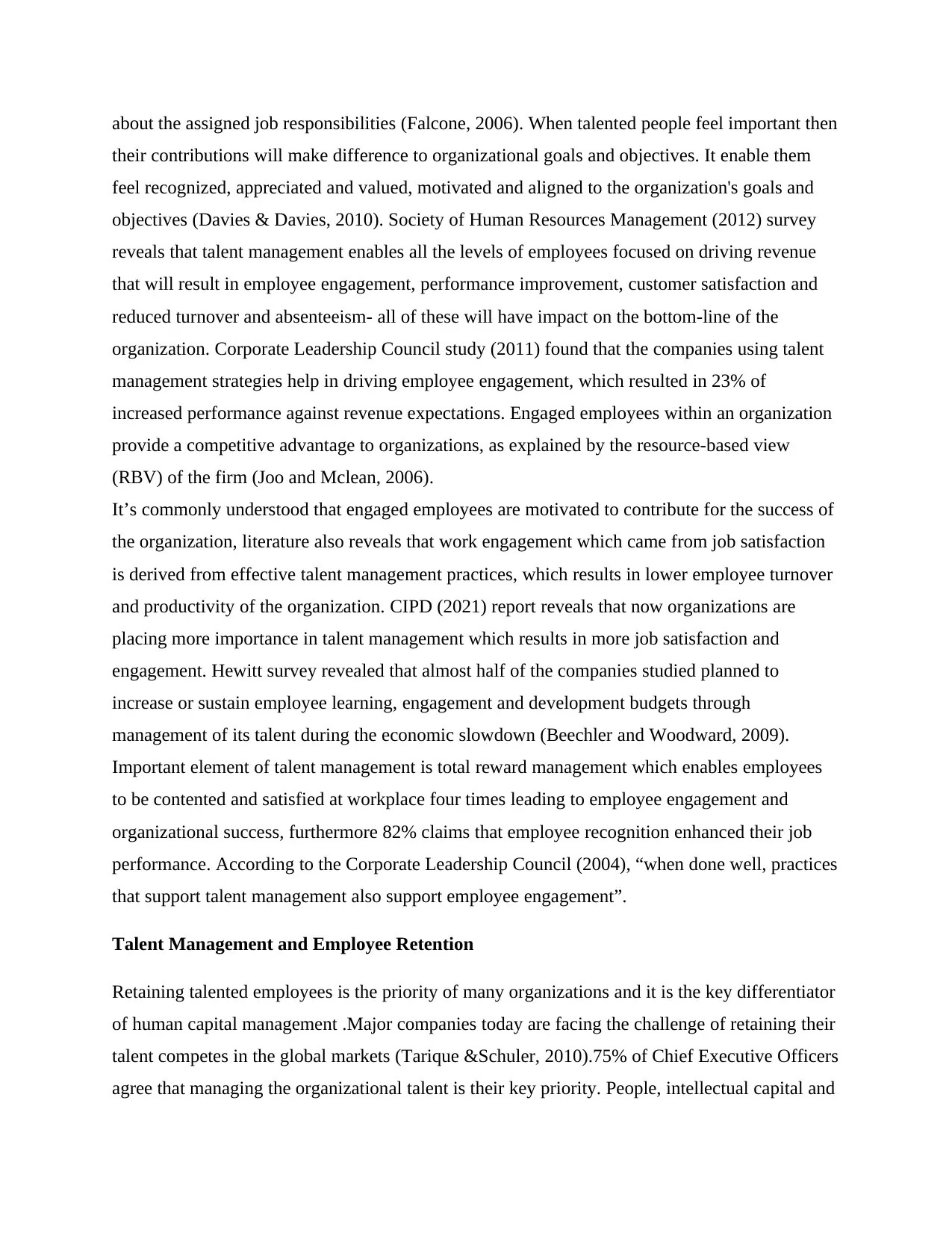
about the assigned job responsibilities (Falcone, 2006). When talented people feel important then
their contributions will make difference to organizational goals and objectives. It enable them
feel recognized, appreciated and valued, motivated and aligned to the organization's goals and
objectives (Davies & Davies, 2010). Society of Human Resources Management (2012) survey
reveals that talent management enables all the levels of employees focused on driving revenue
that will result in employee engagement, performance improvement, customer satisfaction and
reduced turnover and absenteeism- all of these will have impact on the bottom-line of the
organization. Corporate Leadership Council study (2011) found that the companies using talent
management strategies help in driving employee engagement, which resulted in 23% of
increased performance against revenue expectations. Engaged employees within an organization
provide a competitive advantage to organizations, as explained by the resource-based view
(RBV) of the firm (Joo and Mclean, 2006).
It’s commonly understood that engaged employees are motivated to contribute for the success of
the organization, literature also reveals that work engagement which came from job satisfaction
is derived from effective talent management practices, which results in lower employee turnover
and productivity of the organization. CIPD (2021) report reveals that now organizations are
placing more importance in talent management which results in more job satisfaction and
engagement. Hewitt survey revealed that almost half of the companies studied planned to
increase or sustain employee learning, engagement and development budgets through
management of its talent during the economic slowdown (Beechler and Woodward, 2009).
Important element of talent management is total reward management which enables employees
to be contented and satisfied at workplace four times leading to employee engagement and
organizational success, furthermore 82% claims that employee recognition enhanced their job
performance. According to the Corporate Leadership Council (2004), “when done well, practices
that support talent management also support employee engagement”.
Talent Management and Employee Retention
Retaining talented employees is the priority of many organizations and it is the key differentiator
of human capital management .Major companies today are facing the challenge of retaining their
talent competes in the global markets (Tarique &Schuler, 2010).75% of Chief Executive Officers
agree that managing the organizational talent is their key priority. People, intellectual capital and
their contributions will make difference to organizational goals and objectives. It enable them
feel recognized, appreciated and valued, motivated and aligned to the organization's goals and
objectives (Davies & Davies, 2010). Society of Human Resources Management (2012) survey
reveals that talent management enables all the levels of employees focused on driving revenue
that will result in employee engagement, performance improvement, customer satisfaction and
reduced turnover and absenteeism- all of these will have impact on the bottom-line of the
organization. Corporate Leadership Council study (2011) found that the companies using talent
management strategies help in driving employee engagement, which resulted in 23% of
increased performance against revenue expectations. Engaged employees within an organization
provide a competitive advantage to organizations, as explained by the resource-based view
(RBV) of the firm (Joo and Mclean, 2006).
It’s commonly understood that engaged employees are motivated to contribute for the success of
the organization, literature also reveals that work engagement which came from job satisfaction
is derived from effective talent management practices, which results in lower employee turnover
and productivity of the organization. CIPD (2021) report reveals that now organizations are
placing more importance in talent management which results in more job satisfaction and
engagement. Hewitt survey revealed that almost half of the companies studied planned to
increase or sustain employee learning, engagement and development budgets through
management of its talent during the economic slowdown (Beechler and Woodward, 2009).
Important element of talent management is total reward management which enables employees
to be contented and satisfied at workplace four times leading to employee engagement and
organizational success, furthermore 82% claims that employee recognition enhanced their job
performance. According to the Corporate Leadership Council (2004), “when done well, practices
that support talent management also support employee engagement”.
Talent Management and Employee Retention
Retaining talented employees is the priority of many organizations and it is the key differentiator
of human capital management .Major companies today are facing the challenge of retaining their
talent competes in the global markets (Tarique &Schuler, 2010).75% of Chief Executive Officers
agree that managing the organizational talent is their key priority. People, intellectual capital and
Paraphrase This Document
Need a fresh take? Get an instant paraphrase of this document with our AI Paraphraser
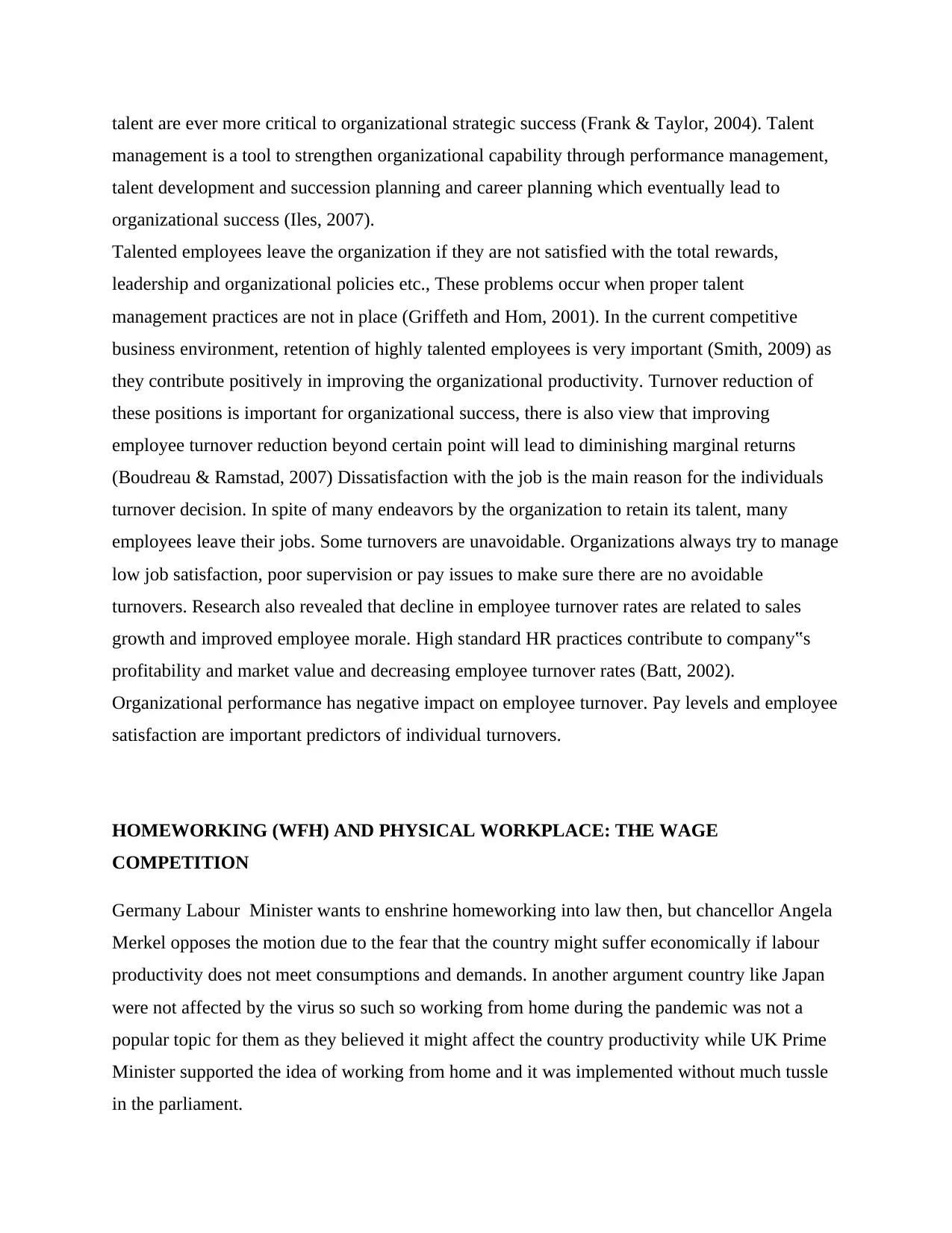
talent are ever more critical to organizational strategic success (Frank & Taylor, 2004). Talent
management is a tool to strengthen organizational capability through performance management,
talent development and succession planning and career planning which eventually lead to
organizational success (Iles, 2007).
Talented employees leave the organization if they are not satisfied with the total rewards,
leadership and organizational policies etc., These problems occur when proper talent
management practices are not in place (Griffeth and Hom, 2001). In the current competitive
business environment, retention of highly talented employees is very important (Smith, 2009) as
they contribute positively in improving the organizational productivity. Turnover reduction of
these positions is important for organizational success, there is also view that improving
employee turnover reduction beyond certain point will lead to diminishing marginal returns
(Boudreau & Ramstad, 2007) Dissatisfaction with the job is the main reason for the individuals
turnover decision. In spite of many endeavors by the organization to retain its talent, many
employees leave their jobs. Some turnovers are unavoidable. Organizations always try to manage
low job satisfaction, poor supervision or pay issues to make sure there are no avoidable
turnovers. Research also revealed that decline in employee turnover rates are related to sales
growth and improved employee morale. High standard HR practices contribute to company‟s
profitability and market value and decreasing employee turnover rates (Batt, 2002).
Organizational performance has negative impact on employee turnover. Pay levels and employee
satisfaction are important predictors of individual turnovers.
HOMEWORKING (WFH) AND PHYSICAL WORKPLACE: THE WAGE
COMPETITION
Germany Labour Minister wants to enshrine homeworking into law then, but chancellor Angela
Merkel opposes the motion due to the fear that the country might suffer economically if labour
productivity does not meet consumptions and demands. In another argument country like Japan
were not affected by the virus so such so working from home during the pandemic was not a
popular topic for them as they believed it might affect the country productivity while UK Prime
Minister supported the idea of working from home and it was implemented without much tussle
in the parliament.
management is a tool to strengthen organizational capability through performance management,
talent development and succession planning and career planning which eventually lead to
organizational success (Iles, 2007).
Talented employees leave the organization if they are not satisfied with the total rewards,
leadership and organizational policies etc., These problems occur when proper talent
management practices are not in place (Griffeth and Hom, 2001). In the current competitive
business environment, retention of highly talented employees is very important (Smith, 2009) as
they contribute positively in improving the organizational productivity. Turnover reduction of
these positions is important for organizational success, there is also view that improving
employee turnover reduction beyond certain point will lead to diminishing marginal returns
(Boudreau & Ramstad, 2007) Dissatisfaction with the job is the main reason for the individuals
turnover decision. In spite of many endeavors by the organization to retain its talent, many
employees leave their jobs. Some turnovers are unavoidable. Organizations always try to manage
low job satisfaction, poor supervision or pay issues to make sure there are no avoidable
turnovers. Research also revealed that decline in employee turnover rates are related to sales
growth and improved employee morale. High standard HR practices contribute to company‟s
profitability and market value and decreasing employee turnover rates (Batt, 2002).
Organizational performance has negative impact on employee turnover. Pay levels and employee
satisfaction are important predictors of individual turnovers.
HOMEWORKING (WFH) AND PHYSICAL WORKPLACE: THE WAGE
COMPETITION
Germany Labour Minister wants to enshrine homeworking into law then, but chancellor Angela
Merkel opposes the motion due to the fear that the country might suffer economically if labour
productivity does not meet consumptions and demands. In another argument country like Japan
were not affected by the virus so such so working from home during the pandemic was not a
popular topic for them as they believed it might affect the country productivity while UK Prime
Minister supported the idea of working from home and it was implemented without much tussle
in the parliament.
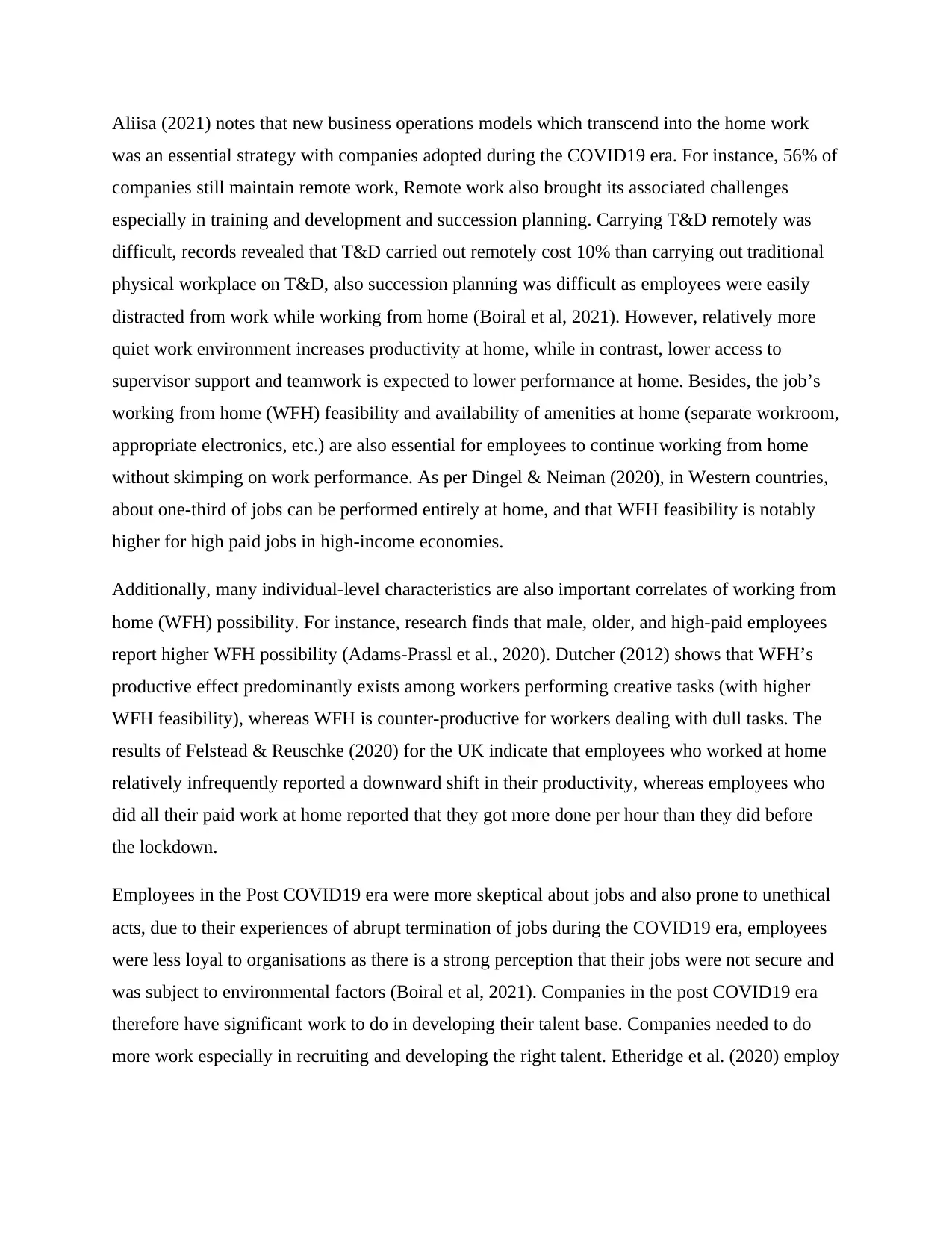
Aliisa (2021) notes that new business operations models which transcend into the home work
was an essential strategy with companies adopted during the COVID19 era. For instance, 56% of
companies still maintain remote work, Remote work also brought its associated challenges
especially in training and development and succession planning. Carrying T&D remotely was
difficult, records revealed that T&D carried out remotely cost 10% than carrying out traditional
physical workplace on T&D, also succession planning was difficult as employees were easily
distracted from work while working from home (Boiral et al, 2021). However, relatively more
quiet work environment increases productivity at home, while in contrast, lower access to
supervisor support and teamwork is expected to lower performance at home. Besides, the job’s
working from home (WFH) feasibility and availability of amenities at home (separate workroom,
appropriate electronics, etc.) are also essential for employees to continue working from home
without skimping on work performance. As per Dingel & Neiman (2020), in Western countries,
about one-third of jobs can be performed entirely at home, and that WFH feasibility is notably
higher for high paid jobs in high-income economies.
Additionally, many individual-level characteristics are also important correlates of working from
home (WFH) possibility. For instance, research finds that male, older, and high-paid employees
report higher WFH possibility (Adams-Prassl et al., 2020). Dutcher (2012) shows that WFH’s
productive effect predominantly exists among workers performing creative tasks (with higher
WFH feasibility), whereas WFH is counter-productive for workers dealing with dull tasks. The
results of Felstead & Reuschke (2020) for the UK indicate that employees who worked at home
relatively infrequently reported a downward shift in their productivity, whereas employees who
did all their paid work at home reported that they got more done per hour than they did before
the lockdown.
Employees in the Post COVID19 era were more skeptical about jobs and also prone to unethical
acts, due to their experiences of abrupt termination of jobs during the COVID19 era, employees
were less loyal to organisations as there is a strong perception that their jobs were not secure and
was subject to environmental factors (Boiral et al, 2021). Companies in the post COVID19 era
therefore have significant work to do in developing their talent base. Companies needed to do
more work especially in recruiting and developing the right talent. Etheridge et al. (2020) employ
was an essential strategy with companies adopted during the COVID19 era. For instance, 56% of
companies still maintain remote work, Remote work also brought its associated challenges
especially in training and development and succession planning. Carrying T&D remotely was
difficult, records revealed that T&D carried out remotely cost 10% than carrying out traditional
physical workplace on T&D, also succession planning was difficult as employees were easily
distracted from work while working from home (Boiral et al, 2021). However, relatively more
quiet work environment increases productivity at home, while in contrast, lower access to
supervisor support and teamwork is expected to lower performance at home. Besides, the job’s
working from home (WFH) feasibility and availability of amenities at home (separate workroom,
appropriate electronics, etc.) are also essential for employees to continue working from home
without skimping on work performance. As per Dingel & Neiman (2020), in Western countries,
about one-third of jobs can be performed entirely at home, and that WFH feasibility is notably
higher for high paid jobs in high-income economies.
Additionally, many individual-level characteristics are also important correlates of working from
home (WFH) possibility. For instance, research finds that male, older, and high-paid employees
report higher WFH possibility (Adams-Prassl et al., 2020). Dutcher (2012) shows that WFH’s
productive effect predominantly exists among workers performing creative tasks (with higher
WFH feasibility), whereas WFH is counter-productive for workers dealing with dull tasks. The
results of Felstead & Reuschke (2020) for the UK indicate that employees who worked at home
relatively infrequently reported a downward shift in their productivity, whereas employees who
did all their paid work at home reported that they got more done per hour than they did before
the lockdown.
Employees in the Post COVID19 era were more skeptical about jobs and also prone to unethical
acts, due to their experiences of abrupt termination of jobs during the COVID19 era, employees
were less loyal to organisations as there is a strong perception that their jobs were not secure and
was subject to environmental factors (Boiral et al, 2021). Companies in the post COVID19 era
therefore have significant work to do in developing their talent base. Companies needed to do
more work especially in recruiting and developing the right talent. Etheridge et al. (2020) employ
⊘ This is a preview!⊘
Do you want full access?
Subscribe today to unlock all pages.

Trusted by 1+ million students worldwide
1 out of 24
Related Documents
Your All-in-One AI-Powered Toolkit for Academic Success.
+13062052269
info@desklib.com
Available 24*7 on WhatsApp / Email
![[object Object]](/_next/static/media/star-bottom.7253800d.svg)
Unlock your academic potential
Copyright © 2020–2025 A2Z Services. All Rights Reserved. Developed and managed by ZUCOL.





